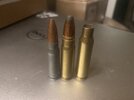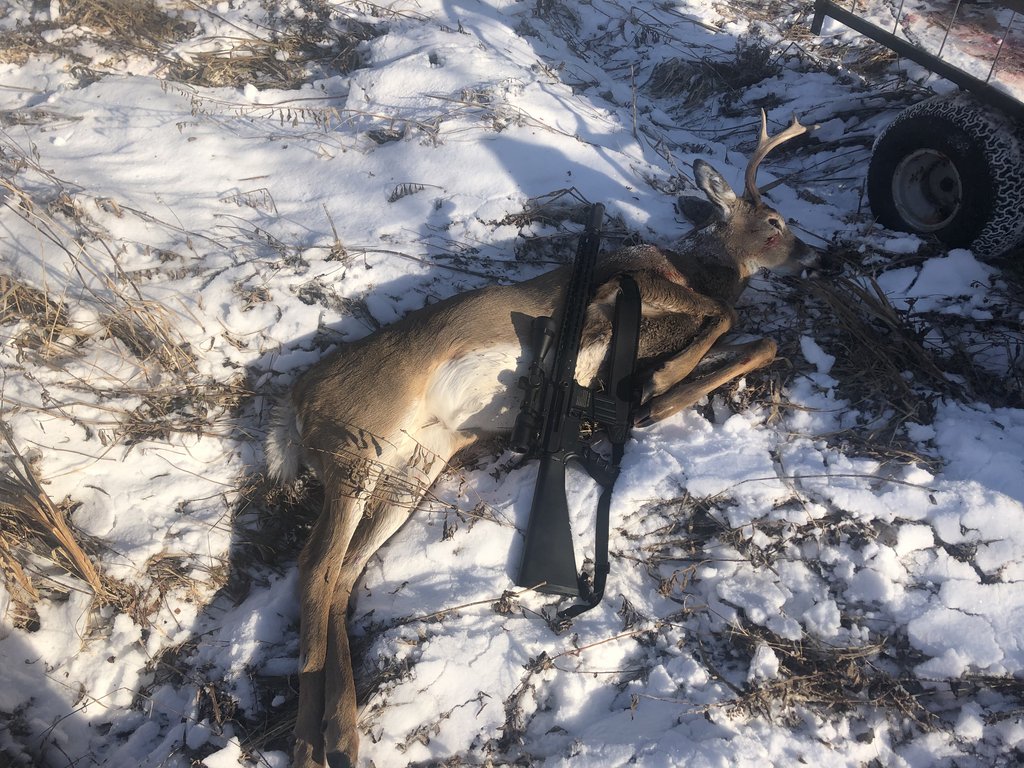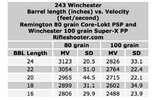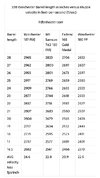If all common deer rifle calibers experience a decline in muzzle velocity when moving from a longer to shorter barrel, is there any caliber in particular that is more suited for a short barrel like 16"? Which cartridge may experience the least amount of velocity loss when moving from say a 22 or 24" barrel to a 16" barrel? or do they all lose about the same amount of velocity?
You are using an out of date browser. It may not display this or other websites correctly.
You should upgrade or use an alternative browser.
You should upgrade or use an alternative browser.
Best caliber for a 16" deer rifle
- Thread starter Balrog
- Start date
Short barrels get annoying with hot rod rounds.
I had a 16.25" Contender "Super 16" in .35 rem that wasnt bad, other than being too muzzle light and funky looking.
Added weight to the synth forend and it was easier to shoot well (but still looked funky.
Straight barrel 18 inch or so and it'd proly still be here.
I had a 16.25" Contender "Super 16" in .35 rem that wasnt bad, other than being too muzzle light and funky looking.
Added weight to the synth forend and it was easier to shoot well (but still looked funky.
Straight barrel 18 inch or so and it'd proly still be here.
md7
Member
308 doesn’t start with much, but it also doesn’t lose much going short either. 20 to 25 fps per inch of barrel is what I commonly see referenced though each barrel is a law unto itself.
A lot of folks, myself included, run 18” to 20” in 308 as suppressor hosts. Mines 18” and should be fine on medium game out to 400 with most cup and core and beyond 500 yards with higher BC, premium bullets.
Academic for me, though. I prefer to stay around 300 yards regardless of barrel length.
That’s 308. Not sure how other cartridges perform.
A lot of folks, myself included, run 18” to 20” in 308 as suppressor hosts. Mines 18” and should be fine on medium game out to 400 with most cup and core and beyond 500 yards with higher BC, premium bullets.
Academic for me, though. I prefer to stay around 300 yards regardless of barrel length.
That’s 308. Not sure how other cartridges perform.
LocoGringo
Member
Not sure about this "all common deer rifle calibers". How common are you talking? .243, 6.5 Creedmoor, 7mm-08, .308, .30-06, 30-30 or do you throw in a 6.5 Grendel, 6.8 SPC, 300 BLK, etc.?
Varminterror
Member
- Joined
- Jul 17, 2016
- Messages
- 14,958
The shorter the barrel - the faster the powder and the closer to straight-wall cartridges.
Over-bore cartridges require barrel length and slow powder.
Neither of these are true. It’s exceptionally sad that so many folks seem to enjoy kicking this red herring down the road. What a waste.
I’m out.
Neither of these are true. It’s exceptionally sad that so many folks seem to enjoy kicking this red herring down the road. What a waste.
I’m out.
Well I for one would be eager to learn. I have no preconceptions in this area; just want to learn something new. Mostly a pistol shooter but always interested in rifles more in the abstract I guess.
BreechFace
Member
- Joined
- Mar 2, 2020
- Messages
- 3,512
Are you seeking suggestions on caliber for hunting? If so, what is you max distance you need for this rifle? Or just an academic question?
BreechFace
Member
- Joined
- Mar 2, 2020
- Messages
- 3,512
I’ve looked into this in the past.
Using the 243WIN and 308WIN illustrates that the larger bore with great surface area at its base will lose less with a reduction of barrel length.
Obviously, there are other variables with regards to loading (fast vs slow powders, etc) And velocity isn’t everything.
But with barrel cutdown tests below the average delta of velocity loss from 24” down to 16” with two different loadings is shown below:
243WIN
80gr average loss 104fps / 2” barrel reduction
100gr average loss 85fps / 2” barrel reduction
308WIN
147gr average loss 57fps / 2” barrel reduction
168gr average loss 42fps / 2” barrel reduction
Using the 243WIN and 308WIN illustrates that the larger bore with great surface area at its base will lose less with a reduction of barrel length.
Obviously, there are other variables with regards to loading (fast vs slow powders, etc) And velocity isn’t everything.
But with barrel cutdown tests below the average delta of velocity loss from 24” down to 16” with two different loadings is shown below:
243WIN
80gr average loss 104fps / 2” barrel reduction
100gr average loss 85fps / 2” barrel reduction
308WIN
147gr average loss 57fps / 2” barrel reduction
168gr average loss 42fps / 2” barrel reduction
Attachments
Last edited:
Varminterror
Member
- Joined
- Jul 17, 2016
- Messages
- 14,958
Well I for one would be eager to learn. I have no preconceptions in this area; just want to learn something new. Mostly a pistol shooter but always interested in rifles more in the abstract I guess.
It's really pretty simple. When you examine pressure curves in internal ballistics, it's clear why it remains true that the most appropriate powder for a given cartridge and bullet weight in a long barrel remains the most appropriate powder for the same cartridge and bullet weight in a short barrel. Yes, using a faster powder can reduce muzzle blast by reducing muzzle pressure, but at the consequence of reduced muzzle velocity as well (reduced overall net force exerted on the bullet by depressing the pressure curve).
There's a user here with a 375 Cheytac in a specialty pistol. You might imagine that cartridge is quite "over bore". Lots of folks have been shooting specialty pistols for decades, this isn't unknown science.
I've never quite understood why anyone hangs themselves up on how much velocity loses per inch than another. If we want efficiency, none of us would shoot centerfire cartridge barrels less than 40", because even "not over bore" cartridges like 308win are still gaining speed long past 30"... But we've been shooting "highly inefficient" 308's with "under-length barrels" for over 70 years...
Just like any firearm choice, pick a bullet which should suit the task you're trying to accomplish, then pick a cartridge case to put behind it which gets it to the speed you need to do the task... It really is that simple.
huntersdog
Member
- Joined
- Apr 9, 2017
- Messages
- 53
Most lever action rounds, .223 with the right bullet, .243, .308, 350 legend, .450 Bushmaster.
someguy2800
Member
Increasing the bore size increases the surface area that the gasses have to push on the bullet, so you can get more velocity for a given bullet weight, but of course you trade that off in sectional density and ballistic coefficient after the bullet leaves the muzzle so there is a balance that needs to be found depending on your intended range.
Short fat large bore cartridges with short fat bullets and relatively fast burning powders are very efficient at making a lot of energy in a short barrel with very efficient powder usage. Straight walls are the extreme end of the trend.
If the goal is to make the most energy or velocity then you have to define where you want to measure that energy or velocity. Large bore straight wall cartridges will make the most muzzle energy per grain of powder used every time. But if you want the most energy at 200 yards or 500 yards, the big bores will loose that contest because of ballistic coefficient. The energy get wasted pushing air out of its way.
If you don’t care about being efficient or not shooting fireballs then you can go as big as you like because a 300 win mag will be faster even in a 10” barrel than a 308, but it would be a horrible obnoxious thing to shoot without a suppressor. Whatever cartridge produces the highest velocity at 24” will also be the fastest at 16”, it just won’t be doing it very efficiently.
Short fat large bore cartridges with short fat bullets and relatively fast burning powders are very efficient at making a lot of energy in a short barrel with very efficient powder usage. Straight walls are the extreme end of the trend.
If the goal is to make the most energy or velocity then you have to define where you want to measure that energy or velocity. Large bore straight wall cartridges will make the most muzzle energy per grain of powder used every time. But if you want the most energy at 200 yards or 500 yards, the big bores will loose that contest because of ballistic coefficient. The energy get wasted pushing air out of its way.
If you don’t care about being efficient or not shooting fireballs then you can go as big as you like because a 300 win mag will be faster even in a 10” barrel than a 308, but it would be a horrible obnoxious thing to shoot without a suppressor. Whatever cartridge produces the highest velocity at 24” will also be the fastest at 16”, it just won’t be doing it very efficiently.
Last edited:
someguy2800
Member
My favorite 16” gun I’ve built so far is my 358 yeti. It’s basically a 358 winchester shortened back to the same length as a 223 so it will fit in a standard AR15 with 450 bushmaster mags. The reduced case capacity moves it into the same kind of powder burn range like you would use for a 7.62x39 like 1680 or CFE BLK which are on the very extreme end of the fastest burning rifle powders, so you get 100% powder burn in a 16” barrel and very mild report.
Shown here in the middle between a 7.62x39 and a 308 case

The neat thing is I get 2500 fps with a 180 grain bullet, which is about the same as you can get from a 308 in a 16” barrel, but because we are taking advantage of the larger bore we can do it from a smaller shorter action with 10 grains less powder

Now like I said though it’s trading bore area for sectional density so it’s shooting pretty blunt low BC bullets. It’s easily a 250 yard hunting rifle, but a 308 will out range it.
16” 308’s are notoriously obnoxious to shoot without a suppressor though. Running faster burning power with the higher expansion ratio of a larger bore benefits us here as well though. Running some quick estimates in quickload, a 16” 308 loaded to max will have a muzzle pressure of about 12,000-13,000 psi. 358 yeti is only 7000 psi and 20% less gas mass being ejected. My 358 with a krink brake on the muzzle is exceptionally pleasant to shoot and doesn’t ring my ears hunting.
Shown here in the middle between a 7.62x39 and a 308 case

The neat thing is I get 2500 fps with a 180 grain bullet, which is about the same as you can get from a 308 in a 16” barrel, but because we are taking advantage of the larger bore we can do it from a smaller shorter action with 10 grains less powder

Now like I said though it’s trading bore area for sectional density so it’s shooting pretty blunt low BC bullets. It’s easily a 250 yard hunting rifle, but a 308 will out range it.
16” 308’s are notoriously obnoxious to shoot without a suppressor though. Running faster burning power with the higher expansion ratio of a larger bore benefits us here as well though. Running some quick estimates in quickload, a 16” 308 loaded to max will have a muzzle pressure of about 12,000-13,000 psi. 358 yeti is only 7000 psi and 20% less gas mass being ejected. My 358 with a krink brake on the muzzle is exceptionally pleasant to shoot and doesn’t ring my ears hunting.
Last edited:
Space Ghost
Member
For my area... that's gonna be the .44 magnum, in a levergun.
This is a complex issue. Most modern bottleneck cartridges are quite happy with 20-24" barrels. Within that range of barrel lengths 308 class cartridges will see about 10-20 fps velocity change as barrel length changes. AND, that is an AVERAGE. Often you will see numbers outside that range but the overall average will usually fall in that range. 30-06 class cartridges usually see 20-25 fps velocity change and the 7mm and 30 caliber magnums around 25-35 fps. Big bore magnums will usually see a little less velocity loss.
If you start out with barrels longer than 24" you will still see gains in velocity, but in even smaller increments. I've never seen a centerfire cartridge reach the point where the barrel length is long enough to reduce speed. But I've seen it with 22's at around 24". If you cut shorter than 20" then velocity loss tends to be more per inch.
But this only applies to measured velocity from the SAME barrel as it is cut shorter. You will never get the same speeds from 2 different barrels even with the same length. Somewhere around 25-50 fps is the norm, but I've seen as much as 130 fps difference.
The individual barrel is far more important than 2-4" of barrel length makes. It wouldn't be unusual for a 20" barrel to shoot to the same speed as another 24" barrel if that particular 20" barrel was faster than average and that 24" barrel were "slow". On the other hand, the 24" barrel could be 200 fps faster if it happened to be the "fast" barrel and the 20" barrel were the "slow" barrel.
I've never seen any situation where faster burning powder helped a short barrel shoot faster in a RIFLE. In a HANDGUN yes. The fastest powder in a 26" barrel has always been the fastest powder in a 16" barrel in every test I've seen. Even the slowest burning powder is burned up in 6-8" of barrel. Longer barrels just give more time for the pressure of the burning powder to push the bullet. It isn't needed to burn the powder.
To your original question
Comparing a 16" barrel to a 24" barrel;
A 308 class cartridge will lose 80-160 fps on average.
A 30-06 class cartridge will lose 160-200 fps on average.
A 7mm or 30caliber magnum 200-280 fps on average.
The 308 class cartridges are more efficient, BUT the 30-06 class and magnum class cartridges start out faster and even though they lose more speed they will still be faster from a 16" barrel.
If you start out with barrels longer than 24" you will still see gains in velocity, but in even smaller increments. I've never seen a centerfire cartridge reach the point where the barrel length is long enough to reduce speed. But I've seen it with 22's at around 24". If you cut shorter than 20" then velocity loss tends to be more per inch.
But this only applies to measured velocity from the SAME barrel as it is cut shorter. You will never get the same speeds from 2 different barrels even with the same length. Somewhere around 25-50 fps is the norm, but I've seen as much as 130 fps difference.
The individual barrel is far more important than 2-4" of barrel length makes. It wouldn't be unusual for a 20" barrel to shoot to the same speed as another 24" barrel if that particular 20" barrel was faster than average and that 24" barrel were "slow". On the other hand, the 24" barrel could be 200 fps faster if it happened to be the "fast" barrel and the 20" barrel were the "slow" barrel.
I've never seen any situation where faster burning powder helped a short barrel shoot faster in a RIFLE. In a HANDGUN yes. The fastest powder in a 26" barrel has always been the fastest powder in a 16" barrel in every test I've seen. Even the slowest burning powder is burned up in 6-8" of barrel. Longer barrels just give more time for the pressure of the burning powder to push the bullet. It isn't needed to burn the powder.
To your original question
Comparing a 16" barrel to a 24" barrel;
A 308 class cartridge will lose 80-160 fps on average.
A 30-06 class cartridge will lose 160-200 fps on average.
A 7mm or 30caliber magnum 200-280 fps on average.
The 308 class cartridges are more efficient, BUT the 30-06 class and magnum class cartridges start out faster and even though they lose more speed they will still be faster from a 16" barrel.
There's always going to be compromises with different cartridges.
Best compromise is an oxymoron.
I do think there can be a range where Goldilocks exists someplace before a diminishing return occurs, which way to lean in this range depends a bunch on what and how you hunt.
Best compromise is an oxymoron.
I do think there can be a range where Goldilocks exists someplace before a diminishing return occurs, which way to lean in this range depends a bunch on what and how you hunt.
someguy2800
Member
I'd be more concerned with blast vs velocity loss.
Under 22" in .243 win and they IMHO get annoying.
Yeah that is where it is at for me. Finding the balance between getting the ballistics you need without feeling like there is a bomb going off at the end of your barrel.
Riomouse911
Member
I have a Ruger 77 RSI with the 18.5” barrel in .243.I'd be more concerned with blast vs velocity loss.
Under 22" in .243 win and they IMHO get annoying.
I wholeheartedly agree the report from this gun is worse than any of my others, save the .300 Weatherby.
Stay safe.
Rebel Dave
Member
Well..... I just got a Ruger American Predator in .308 win, with an 18 inch BBL., so I will find out about the blast concept.
Dave
Dave
BreechFace
Member
- Joined
- Mar 2, 2020
- Messages
- 3,512
Not as bad as an 18” 243winWell..... I just got a Ruger American Predator in .308 win, with an 18 inch BBL., so I will find out about the blast concept.
Dave
.308 Norma
Member
I don't doubt that! My wife had a 20" 243 (a Remington 660) and even that was bad enough.Not as bad as an 18” 243win
Of course, when it comes to muzzle blast, my wife's 20" 243 didn't hold a candle to my 14" XP-100 7mm IHMSA (a "necked down" 300 Savage).
dobedo
Member
Apples and oranges I shoot a Henry 45/70 with a 24" barrel and a BHA Carbine with 16" barrel in .500 S&W magnum.
The average FPS in the 45/70 ranges from 1500 to 2200 FPS and the .500 ranges from 1300-1900 FPS pretty much matched.
However, the .500 pressure is far greater than that of the 45/70. The 45/70 can reach pressures of 39,000 psi. Where the .500 can reach pressures over 54,000 psi. I shoot 350 grain hand loads in each at 100 yards. The 45-70 drops about 1 inch in 100 yards and the .500 drops about 1.75" at 100 yards. The difference is the burn rates of pistol and rifle powders. le powder. So, the faster the powder the higher the pressure gradient is.
The average FPS in the 45/70 ranges from 1500 to 2200 FPS and the .500 ranges from 1300-1900 FPS pretty much matched.
However, the .500 pressure is far greater than that of the 45/70. The 45/70 can reach pressures of 39,000 psi. Where the .500 can reach pressures over 54,000 psi. I shoot 350 grain hand loads in each at 100 yards. The 45-70 drops about 1 inch in 100 yards and the .500 drops about 1.75" at 100 yards. The difference is the burn rates of pistol and rifle powders. le powder. So, the faster the powder the higher the pressure gradient is.
someguy2800
Member
I was curious so I ran it in quickload. A 16" barrel 243 win would have a muzzle pressure of 17,000 to 20,000 psi. Ouch.
Varminterror
Member
- Joined
- Jul 17, 2016
- Messages
- 14,958
I was curious so I ran it in quickload. A 16" barrel 243 win would have a muzzle pressure of 17,000 to 20,000 psi. Ouch.
What’s the muzzle pressure at 10”? My 15” 6 creed was born a 10” 243win.
Similar threads
- Replies
- 10
- Views
- 745
- Replies
- 5
- Views
- 1K
- Replies
- 10
- Views
- 2K



